Abstract
Optical isomers of short peptide Lysine-Tryptophan-Lysine (Lys-{L/D-Trp}-Lys) and Lys-Trp-Lys with an acetate counter-ion were used to study photoinduced intramolecular and intermolecular processes of interest in photobiology. A comparison of L- and D-amino acid reactivity is also the focus of scientists’ attention in various specialties because today, the presence of amyloid proteins with D-amino acids in the human brain is considered one of the leading causes of Alzheimer’s disease. Since aggregated amyloids, mainly Aβ42, are highly disordered peptides that cannot be studied with traditional NMR and X-ray techniques, it is trending to explore the reasons for differences between L- and D-amino acids using short peptides, as in our article. Using NMR, chemically induced dynamic nuclear polarization (CIDNP) and fluorescence techniques allowed us to detect the influence of tryptophan (Trp) optical configuration on the peptides fluorescence quantum yields, bimolecular quenching rates of Trp excited state, and the photocleavage products formation. Thus, compared with the D-analog, the L-isomer shows a greater Trp excited state quenching efficiency with the electron transfer (ET) mechanism. There are experimental confirmations of the hypothesis about photoinduced ET between Trp and the CONH peptide bond, as well as between Trp and another amide group.
1. Introduction
The effect of light exposure on proteins is attracting attention due to the widespread use of the latter in practice [1,2,3,4,5,6]. These are photobiology, medicine, and the research of protein reactions, including photoinduced polymerization. For short peptides, the main pathways of photoinduced transformations have already been established [7,8,9] (Scheme 1).

Scheme 1.
Possible pathways for photocleavage of peptides, where R1 and R2–sidechain amino acid sequences. Adapted with permission from [8]. Copyright 1991 American Chemical Society.
The use of several physical methods, including ESR, has led to the assumption that most cleavage pathways are radical and, in some cases, begin with electron transfer (ET), resulting in the formation of a biradical-zwitterion (BZ). Thus, according to [8], cyclization of the glycyltryptophan occurs in BZ (Scheme 2).

Scheme 2.
Cyclization of glycyltryptophan according to [8]. Reprinted with permission from [8]. Copyright 1991 American Chemical Society.
In addition, much attention is paid to the role of ET in photophysical processes in proteins, e.g., in the quenching of tryptophan (Trp) fluorescence. It is well known that Trp fluorescence is highly sensitive to the microenvironment and is widely used to study the structure of proteins [10,11,12]. Two quenching mechanisms are generally considered: Förster energy transfer and ET [2]. However, there are no direct observations of ET between amino acid fragments and the peptide bond CONH. In addition, Scheme 1 and Scheme 2 proposed in the literature remain hypothetical. Therefore, an indirect but highly sensitive method for detecting paramagnetic species in the reaction—chemically induced dynamic nuclear polarization (CIDNP) seems appropriate.
The CIDNP phenomenon manifests in the NMR spectra of products formed from a pair of radicals with a non-Boltzmann population of nuclear spin sublevels [13]. An enhanced signal absorption or emission is observed when the reaction is carried out directly in the probe of the NMR spectrometer. An analysis of polarized signals allows one to obtain “portraits” of the paramagnetic precursors of the products. Recently, CIDNP has demonstrated a new phenomenon—spin selectivity in the processes of photoinduced ET in chiral systems. Spin selectivity is a difference in the CIDNP enhancement coefficients for diastereomers with different optical configurations [14,15]. This finding allows us to expect that the CIDNP study of photoinduced processes in short peptides on the examples of Lysine-Tryptophan-Lysine (Lys-Trp-Lys) acetate salt and Lys-{L/D-Trp}-Lys with N-terminal acetylation will provide answers to some crucial questions. First, this is an experimental confirmation of the hypothesis of ET between amino acids in peptides and the CONH peptide bonds. Second, this is the exploration of differences in the reactivity of systems with L- and D-amino acids [12]. It is crucial since replacing L-amino acids with D-analogs during aging causes Alzheimer’s and Parkinson’s diseases, type 2 diabetes, and several other ailments [16,17,18]. The presence of D-isomers of amino acids has been shown to result in disturbances in folding processes, leading to the aggregation of highly disordered amyloid proteins and peptides, forming large oligomers or fibrils, which have a toxic effect and destroy the brain. The current trend in studying the difference between L- and D-amino acids in highly disordered proteins and peptides is using short peptides as an example [17,18]. This approach to solving this problem is proposed in the literature since highly disordered proteins cannot be studied using high-resolution magnetic resonance and X-ray spectroscopy [17]. In this regard, an investigation of short peptides containing L- or D-Trp residues allows us to trace the differences between the reactivity of its optical isomers since Lys-{L/D-Trp}-Lys serves as a convenient model due to the strong fluorescence of Trp residue. Thus, this article will investigate the physical and chemical pathways of degradation of the Trp excited states in the composition of the peptides using 1H NMR, CIDNP, and fluorescence techniques.
2. Results and Discussion
Next, we will consider sequentially the photophysical and photochemical processes occurring during the quenching of the excited states of Trp in peptides I–III (Figure 1).

Figure 1.
The structural formula of N-acetyl Lys-{L/D-Trp}-Lys peptide (I, II) and Lys-Trp-Lys acetate salt (III) (counter-ions not shown).
2.1. Fluorescence Quenching Processes in Lys-Trp-Lys
The emission spectra of I–III compared with L-N-acetyltryptophan (L-NAcTrp) in an aqueous solution with corresponding quantum yields and fluorescence decay traces are shown in Figure 2 and Table 1.
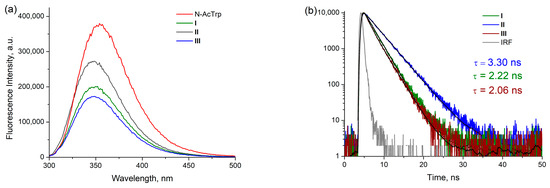
Figure 2.
Fluorescence spectra of isoabsorptive aqueous solutions of I–III and L-N-acetyltryptophan (N-AcTrp, λex = 280 nm) in 1 cm cuvette (a), fluorescence decay traces of I–III at 350 nm (λex = 270 nm), IRF—instrument response function (b). Absorption spectra are given in Figure S1 (Supplementary Materials).

Table 1.
Fluorescence quantum yields (φ) and lifetimes (τ) for studied peptides I–III at 296 K in aqueous solutions.
The fluorescence decay traces of the peptides I–III are described with two exponential models (see Table 1). As a rule, the multiexponential fluorescence decay of Trp, as part of a protein and peptide, was associated with short-lived and long-lived rotamers of Trp. There are a several models proposed to explain multi-exponential fluorescence decay [11].
As can be seen from Table 1, the highest fluorescence quantum yield (i.e., the lowest efficiency of quenching of the Trp singlet excited state) is observed for the D-optical isomer of peptide II. Moreover, there is a remarkable difference in the distribution of fluorescence decay times A1 and A2 in I–III. This seems to be the result of different contributions of short-lived rotamers in the isomers of peptides.
2.2. 1H NMR Investigation of Lys-Trp-Lys Photolysis Products
The 1H NMR spectra of peptides’ aqueous solutions are shown in Figure 3 and Figures S2–S4. UV irradiation of aqueous solutions of peptides was carried out directly in the NMR spectrometer probe, making it possible to follow the formation of products and detect radical species using the CIDNP technique [13,19].
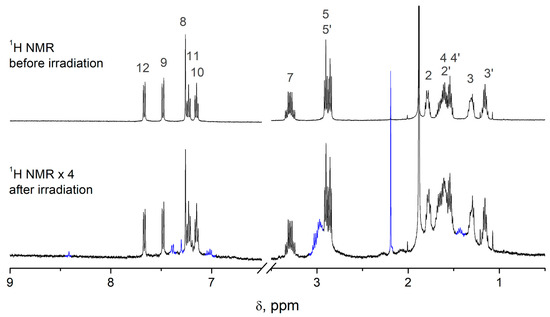
Figure 3.
500 MHz 1H NMR spectra of 3 mM solution of peptide III before and after photolysis in water-d2; photolysis products are marked by blue color.
After durational UV irradiation, product signals are observed only for peptide III (Figure 3). A quantitative analysis of the intensities ratios in the NMR spectra shows that products in cases I and II are also formed. Nevertheless, their signals overlap with the signals of the initial peptides (see Figures S2–S4, Supplementary Materials). To detect product signals, we compared the integral signal intensities of I–III in solutions before and after photolysis and the ratios of individual lines in the reaction mixture with those in the starting compounds before photolysis. Tables S1–S3 with the analysis of deviations in the balance of signal intensities from those for the initial I–III are given in Supplementary Materials. These deviations reflect the process of peptide cleavage. Similar changes in the intensity of the NMR signals of different protons indicate the formation of a single product and aid in establishing its possible structure. An analysis of these changes in the integral intensities shows that the degree of photocleavage is minimal for peptide I; on average, it does not exceed 15% relative to the signal intensity of the initial peptide with an accuracy of 10%. The maximum change is shown by proton 1, located in the central part of the molecule. This change points to the decarboxylation process, which slightly alters the position of the lines in the product compared to the initial one (Scheme 3).

Scheme 3.
Photoinduced decarboxylation of peptide I involve eliminating carbon dioxide and proton transfer from the solvent to the resulting carbene.
The most significant changes in the intensities of NMR signals are characteristic for peptides II and III. Changes in the integral intensity of peptide II mainly concern the protons of the Trp moiety (7, 8–12), 1, 1′ and the N-acetyl group, and as in the case of I, do not increase with increasing concentration from 1 to 8 mM (Tables S1 and S2 in Supplementary Materials). The latter indicates that the products were mainly formed in an intramolecular process. On the other hand, according to the general scheme of photoinduced radical processes typical for peptides given in the Introduction, a change in the protons intensities of the Trp moiety and 1, 1′ indicates the detachment of the Trp sidechain and cleavage of peptide bonds. It can be assumed that photoinduced radical cleavage of the C6–C7 bond in peptide II results in yielding the main product—3-methyleneindolenine. Simulation of the NMR spectrum of 3-methyleneindolenine does not contradict this assumption (Figure S2). The second product could be a dimer formed from peptide residues (Scheme 4). The participation of radicals in forming dimers of peptides and other proteins under UV irradiation is widely described in the literature [4,5,6].
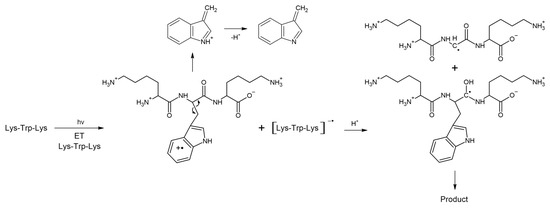
Scheme 4.
Photoinduced cleavage of Trp sidechain by eliminating 3-methylene-3H-indol-1-ium, the protonated form of 3-methyleneindolenine and two radicals recombination product formation.
At the same time, the cleavage of the peptide bond is likely to result in the formation of an aldehyde in the case of peptides II and III (see Supplementary Materials, Figure S3). The scheme describing the possible way of aldehyde formation is also presented in Supplementary Materials (Scheme S1).
As for the acetate salt of peptide III, the maximum changes in the NMR signal intensities concern 12, 9 aromatic protons and 1′, 1, 7 aliphatic protons (Table S3). In addition, during intensive photolysis, product signals accumulate in the region of aromatic protons resonance (Figure 3). Simultaneous changes in the 12, 9, and 1 proton signals suggest forming a cycle similar to that previously described for the glycine-L-tryptophan peptide in [8] (Scheme 2 and Scheme 5). According to the authors of [8], under UV irradiation, the glycine-L-tryptophan peptide cyclization product is formed through the biradical-zwitterion (BZ) result of the intramolecular ET. The results of the NMR spectrum simulation (Figure S4) confirm the possibility of forming such a cycle from peptide III.
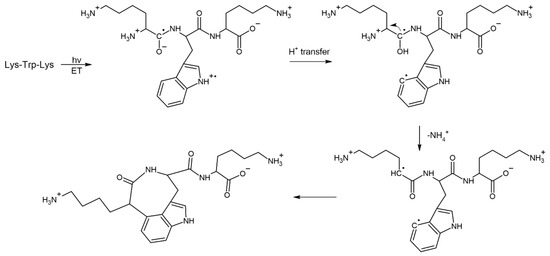
Scheme 5.
Formation of a cyclization product upon UV irradiation of the peptide III.
Moreover, a marked change in the intensities of protons 1′ of peptide III indicates the possible cleavage of the peptide bond, leading to the formation of an aldehyde (Scheme S1).
2.3. Photo-CIDNP Study of Lys-Trp-Lys
In this part, the CIDNP study was used to detect the radical stages postulated in Scheme 3, Scheme 4 and Scheme 5. However, this study has shown that in time-resolved (TR) photo-CIDNP spectra demonstrating intramolecular processes, the effects are absent for all peptides, whereas CIDNP effects appear when using the pseudo-steady state (PSS) experimental technique [19] (Figure 4).
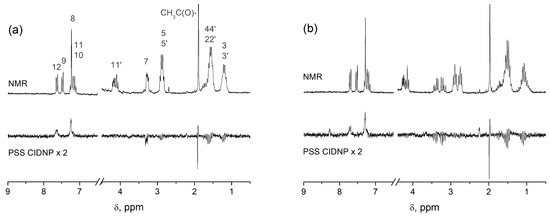
Figure 4.
CIDNP effects of 3 mM solutions of I (a) and II (b) in water-d2.
In this technique, the CIDNP spectra reflect all radical processes—intramolecular and others occurring in bulk, including diffusion quenching of Trp in an excited state by Trp in the ground state. Polarized signals of the following protons have been observed for peptides I–III: aromatic 12, 8 and methylene 7 of the initial compounds. In addition, methyl protons of the N-acetyl group (NHCOCH3) in I and II and proton signals of products (8.3–8.4 ppm) formed from peptides II and III are polarized (Figure S6).
The CIDNP effects analysis of aromatic and methylene protons of Trp moiety in peptides, according to the existing rules for high magnetic fields, corresponds to the occurrence of CIDNP in the triplet pair of the Trp radical-cation and the radical-anion with a paramagnetic center located at the carbonyl group of the peptide bond. This refers to the bond assigned on the N-end of the peptide (Figure 1). Such a radical pair can be formed due to diffusion quenching of the Trp triplet excited state by another Trp moiety in the ground state. The conclusion about the multiplicity of the reactive state of the peptide was made based on the analysis of the CIDNP signs [20,21]. Details of the analysis are presented in Supplementary Materials.
Thus, the analysis shows that the observed CIDNP effects are not from BZ, formed due to intramolecular ET. The concentration dependencies of the CIDNP coefficients for all polarized protons confirm this conclusion (Figure 5 and Figure S5). To obtain the CIDNP coefficients shown in the figures, we had to calculate which fraction of the signal integral intensity in the NMR spectrum after photolysis corresponds to the initial peptide involved in the process of diffusion quenching of the Trp excited state by the carbonyl group of the peptide in the ground state (Tables S1–S3).

Figure 5.
Concentration dependencies of the CIDNP effects for I, II (a) and III (b) peptides.
Concentration dependences of the CIDNP effects for peptides I–II shown in Figure 5 confirm the CIDNP origin suggestion. As a result of the approximation of CIDNP dependence on concentration as a reaction by a pseudo-first-order, we obtained the ratio of ET rate constants in I and II equal 1.65. This conclusion about the L- and D-isomers’ activity difference also correlates with the fluorescence quenching results (Figure 2). In this case, D-isomer II is quenched more slowly than both L-analogs: I and acetate salt III. Since fluorescence quenching is likely to occur through the ET mechanism similar to diffusion quenching of the triplet excited state, it can be concluded that the D optical isomer is less active in the ET process.
Regarding acetate salt III, the rapid plateauing of the curve in Figure 5b is likely to result from the counter-ion influence [22]. Thus, the above results produced experimental evidence of ET between the peptide bond and the Trp moiety in short peptides [2,8,23,24,25]. Note that the reference data indicates intramolecular ET, whereas the TR CIDNP in a high magnetic field in peptides I–III is absent due to the probable presence of an electron exchange interaction in BZ caused by the short distance between donor and acceptor moieties [13].
Nevertheless, the observation of CIDNP suggests that the peptide bond has acceptor properties attributed to it in the literature [2,6,7,23,24,25]. The conclusion about the possibility of ET between amino acids and the CONH bond is mainly based on the analysis of tryptophan and histidine dependencies of fluorescence quantum yields on the microenvironment [2,23,24,25]. This concerns the properties of the nearest groups in a protein or peptide, including charged ones, the length of the chain between the donor and acceptor, and the solvent polarity and pH. There are even examples of a quantitative correlation between the values of the experimental Trp fluorescence quantum yields and those calculated within the framework of the ET model [24]. As a radical pair, in this case, was considered the highest occupied molecular orbital (MO) localized on the Trp indole ring and the lowest free p* MO of the amide group under conditions of strong Coulomb interaction. Thus, the evidence of ET in peptides available so far was indirect while the CIDNP data directly indicate the formation of the Trp radical-cation and the CONH radical-anion.
In addition, we have mentioned above an intense negative polarization of the methyl protons of the N-acetyl group (NHCOCH3) in peptides I and II. The concentration dependence of the CIDNP coefficients of methyl protons for the L- and D-configurations of the peptide is shown in Figure 6.
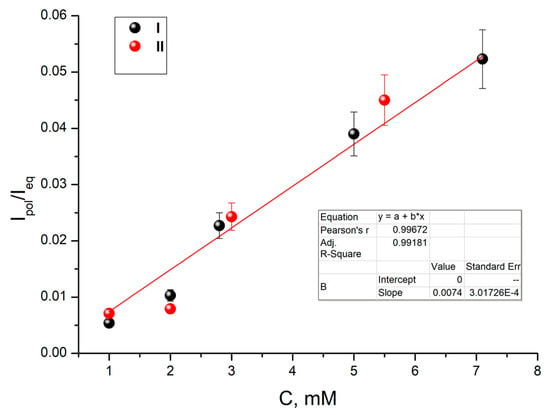
Figure 6.
Concentration dependencies of the CIDNP coefficients of methyl protons of NHCOCH3 group for I and II.
Since the tangent of this dependence (0.007) differs noticeably from those for protons 12 and 7 in Figure 5 (0.038; 0.023; 0.013), it is evident that these dependencies originate from different processes. The CIDNP of methyl protons is assumed to be formed in the radical pair with N-acetyl moiety: NHCOCH3 and Trp residue (Scheme 6). It is worth noting that, in this case, chiral centers do not influence the parameters of Trp singlet excited state quenching. The fact that the singlet excited state is quenched follows from the analysis of the CIDNP sign (S) of the methyl protons of the N-acetyl group (details see Supplementary Materials). The possibility of ET between these peptide moieties was considered in work [22] when calculating the efficiency of ET in N-acetyltryptophanamide. The estimated spin density distribution in the NHCOCH3 radical-anion is presented in Supplementary Materials (Table S4).

Scheme 6.
Two possible paths of photoinduced bimolecular ET: from singlet excited state of Trp in the composition of peptide (only chromophore fragment is shown) to NHCOCH3 group of molecules in the ground state (a) and the same from triplet excited state of Trp to CONH peptide bond (b). RP is presented by pair of radical-anion from peptide bond and indole radical-cation (c).
The short lifetime of the Trp singlet excited state allows us to assume that, in this case, ET occurs under conditions of the formation of a weak collisional complex. It also might be the hydrogen bond between two CONH groups described in the literature [14,15].
3. Materials and Methods
3.1. Spectroscopic Measurements
All UV spectroscopic measurements were performed using a quartz cuvette of 1 cm optical length. Spectra and kinetic luminescence curves were recorded with an Edinburgh Instruments FLSP-920 spectrofluorimeter (Livingston, UK) with either a Xenon lamp or laser diodes EPLED-270 (λex = 270 nm, pulse duration 0.6 ns) as excitation sources. The kinetic traces were fitted with exponential decay functions using a reconvolution procedure (FAST program–version 3.5.2). The fluorescence quantum yields of peptides were determined relative to Trp as standard fluorophore [26] using the following equation [27]:
where, φs—quantum yield of standard fluorophore (0.14 [26]), φu—quantum yield of unknown fluorophore, As—the absorbance of standard fluorophore at the excitation wavelength, Au—the absorbance of unknown fluorophore at the excitation wavelength, Fs—the area of integrated fluorescence intensity of the reference sample when excited at the same excitation wavelength, and Fu—the total area of integrated fluorescence intensity for the unknown sample when excited at the same excitation wavelength. The refractive indices of the solvents for the unknown and the standard samples are denoted by nu and ns, respectively. All fluorescence measurements of isoabsorptive solutions of the standard and peptides were performed in the same solvent–water mixture. The absorption spectra were recorded using an Agilent 8453 spectrophotometer (Santa Clara, CA, USA). All experiments were performed at room temperature 296 K.
3.2. NMR and Photo-CIDNP Measurements
Lys-L-Trp-Lys acetate salt (Bachem, Bubendorf, Switzerland, 99.3%), Lys-L/D-Trp-Lys with N-terminal acetylation (Elabscience, Houston, TX, USA, 95.3%) and the deutero solvent water-d2 (99.9% D, Cambridge Isotope Laboratories, Andover, MA, USA) were used as received. A Bruker Avance HD III NMR spectrometer (500 MHz 1H operating frequency, τ(π/2) = 10 μs) was used to record the 1H NMR spectra of the photoproducts. A Bruker DPX200 NMR spectrometer (200 MHz 1H operating frequency, τ(π/2) = 2.5 μs) was utilized to study the CIDNP effects. The Lambda Physik EMG 101 MSC excimer laser (Göttingen, Germany) was used as a light source (308 nm, 100 mJ, pulse duration 15 ns) in these experiments. The samples were bubbled with argon for 15 min to remove dissolved oxygen and were irradiated directly in the probe of the DPX200 NMR spectrometer. Time-resolved (TR) CIDNP experiments were performed with the following pulse sequence: presaturation, laser pulse (−15 ns), variable time delay, and π/2 radio-frequency registration pulse. The pseudo-steady state (PSS) experiments were proposed to increase the signal-to-noise ratio [19]. In PSS experiments, a standard pulse sequence was used: presaturation, delay 1, pulse τ(π), delay2 (16 laser flashes with repetition rate 50 Hz during delay 2), observation pulse τ(π/2), and acquisition. Delay1/delay2 ≈ 1.1 to remove residual signals of solvents and solutes. After laser irradiation, the 1H NMR spectra of products were recorded. All experiments were performed at room temperature, 296 K.
4. Conclusions
Thus, a joint analysis of peptides I–III fluorescence quenching data and the CIDNP effects formed upon UV irradiation allowed us to arrive at the following conclusions. The data on fluorescence quenching and the relative rates of bimolecular quenching of the triplet excited state of Trp in peptides I–III indicate a greater efficiency of ET in the L-optical isomer than in the D-analog. The manifestation of CIDNP effects in bimolecular processes implies that quenching occurs via the ET mechanism. ET was shown to occur between the donor—Trp moiety while the CONH peptide bond acts as an acceptor. It should be noted that CIDNP detecting on Trp protons is the first, although not direct, confirmation of the paramagnetic form of the CONH group. Another confirmation of the electron-withdrawing properties of the N-acetyl group NHCOCH3 is the presence of CIDNP on its methyl protons in peptides I and II under UV irradiation.
Moreover, considerable differences are observed in the photoinduced transformations of peptides I–III. 1H NMR analysis of the products shows that L-optical isomer I undergo less photodecomposition (15% ± 10%) than salt III and D-analog II. It seems to be a consequence of the high reversibility of ET through which, according to the proposed schemes, the photocleavage products are formed, whereas in the case of salt III with the same optical configuration, the formation of a cyclic product is assumed. In addition, the products of CONH and C6-C7 bonds cleavage—aldehyde and 3-methyleneindolinine—were observed. The photolysis of the D-optical isomer II also results in the formation of aldehyde and 3-methyleneindolinine. Various photocleavage products formed from I and II point to the difference in the reactivity of the L- and D-optical isomers. It is worth mentioning that the same conclusion was drawn from the analysis of spin effects in chiral dyads with L- and D-Trp isomers. Spin effects reflect differences in spin density distribution in paramagnetic precursors, which correlate with the reactivity of compounds in radical processes. In addition, the variety of products shows that the reactivity of these peptides depends not only on the optical configuration, but also on a counter-ion presence. Thus, replacing the amide group in the first position of peptide I with a donor amino group in its salt III results in a radical cleavage of the CONH and C6-C7 bonds.
Supplementary Materials
The following supporting information can be downloaded at: https://www.mdpi.com/article/10.3390/ijms24043331/s1. References [20,21,28,29,30,31,32,33,34] are cited in Supplementary Materials.
Author Contributions
Conceptualization, T.V.L. and A.B.D.; methodology, A.I.K. and I.M.M.; software, I.M.M.; validation, V.F.P.; investigation, A.A.A., R.S.L. and S.O.M.; resources, N.E.P.; writing—original draft preparation, A.A.A. and T.V.L.; writing—review and editing, T.V.L.; project administration, N.E.P. All authors have read and agreed to the published version of the manuscript.
Funding
This research was funded by Russian Science Foundation, grant number 18-13-00047.
Institutional Review Board Statement
Not applicable.
Informed Consent Statement
Not applicable.
Data Availability Statement
Not applicable.
Conflicts of Interest
The authors declare no conflict of interest.
References
- Zheng, Y.; Mao, K.; Chen, S.; Zhu, H. Chirality Effects in Peptide Assembly Structures. Front. Bioeng. Biotechnol. 2021, 9, 703004. [Google Scholar] [CrossRef] [PubMed]
- Ghisaidoobe, A.B.T.; Chung, S.J. Intrinsic Tryptophan Fluorescence in the Detection and Analysis of Proteins: A Focus on Förster Resonance Energy Transfer Techniques. Int. J. Mol. Sci. 2014, 15, 22518–22538. [Google Scholar] [CrossRef] [PubMed]
- Roy, S.; Giri, R.S.; Dolai, G.; Mandal, B. Role of Side-Chain and Chirality of the Amino Acids on the Supramolecular Assemblies of Dipeptides. J. Mol. Struct. 2020, 1221, 128877. [Google Scholar] [CrossRef]
- Guntas, G.; Hallett, R.A.; Zimmerman, S.P.; Williams, T.; Yumerefendi, H.; Bear, J.E.; Kuhlman, B. Engineering an Improved Light-Induced Dimer (ILID) for Controlling the Localization and Activity of Signaling Proteins. Proc. Natl. Acad. Sci. USA 2015, 112, 112–117. [Google Scholar] [CrossRef]
- Ballister, E.R.; Aonbangkhen, C.; Mayo, A.M.; Lampson, M.A.; Chenoweth, D.M. Localized Light-Induced Protein Dimerization in Living Cells Using a Photocaged Dimerizer. Nat. Commun. 2014, 5, 5475. [Google Scholar] [CrossRef]
- Dadashi-Silab, S.; Doran, S.; Yagci, Y. Photoinduced Electron Transfer Reactions for Macromolecular Syntheses. Chem. Rev. 2016, 116, 10212–10275. [Google Scholar] [CrossRef]
- Dillon, J. The Anaerobic Photolysis of Tryptophan Containing Peptides. Photochem. Photobiol. 1980, 32, 37–39. [Google Scholar] [CrossRef]
- Hill, R.R.; Coyle, J.D.; Birch, D.; Dawe, E.; Jeffs, G.E.; Randall, D.; Stec, I.; Stevenson, T.M. Photochemistry of Dipeptides in Aqueous Solution. J. Am. Chem. Soc. 1991, 113, 1805–1817. [Google Scholar] [CrossRef]
- Hill, R.R.; Jeffs, G.E.; Banaghan, F.; McNally, T.; Werninck, A.R. Photo-Induced Electron Transfer in Small Peptides: Glycylalanine. J. Chem. Soc. Perkin Trans. 2 1996, 8, 1595–1599. [Google Scholar] [CrossRef]
- Lazzari, F.; Manfredi, A.; Alongi, J.; Marinotto, D.; Ferruti, P.; Ranucci, E. D-, l- and d,l-Tryptophan-Based Polyamidoamino Acids: PH-Dependent Structuring and Fluorescent Properties. Polymers 2019, 11, 543. [Google Scholar] [CrossRef]
- Vivian, J.T.; Callis, P.R. Mechanisms of Tryptophan Fluorescence Shifts in Proteins. Biophys. J. 2001, 80, 2093–2109. [Google Scholar] [CrossRef] [PubMed]
- Chen, Y.; Liu, B.; Yu, H.-T.; Barkley, M.D. The Peptide Bond Quenches Indole Fluorescence. J. Am. Chem. Soc. 1996, 118, 9271–9278. [Google Scholar] [CrossRef]
- Salikhov, K.M.; Molin, Y.N.; Sagdeev, R.Z.; Buchachenko, A.L. Spin Polarization and Magnetic Effects in Radical Reactions; Akademiai Kiado: Budapest, Hungary, 1984; Volume 22, pp. 65–72. [Google Scholar]
- Ageeva, A.A.; Khramtsova, E.A.; Magin, I.M.; Purtov, P.A.; Miranda, M.A.; Leshina, T.v. Role of Association in Chiral Catalysis: From Asymmetric Synthesis to Spin Selectivity. Chem. Eur. J. 2018, 24, 18587–18600. [Google Scholar] [CrossRef] [PubMed]
- Ageeva, A.A.; Khramtsova, E.A.; Magin, I.M.; Rychkov, D.A.; Purtov, P.A.; Miranda, M.A.; Leshina, T.V. Spin Selectivity in Chiral Linked Systems. Chem. Eur. J. 2018, 24, 3882–3892. [Google Scholar] [CrossRef]
- Chiellini, G. Understanding Amyloid Structures and Disease: A Continuing Challenge in Health Research. Int. J. Mol. Sci. 2021, 22, 6620. [Google Scholar] [CrossRef] [PubMed]
- Raskatov, J.A.; Teplow, D.B. Using Chirality to Probe the Conformational Dynamics and Assembly of Intrinsically Disordered Amyloid Proteins. Sci. Rep. 2017, 7, 12433. [Google Scholar] [CrossRef]
- Ageeva, A.A.; Doktorov, A.B.; Polyakov, N.E.; Leshina, T.V. Chiral Linked Systems as a Model for Understanding D-Amino Acids Influence on the Structure and Properties of Amyloid Peptides. Int. J. Mol. Sci. 2022, 23, 3060. [Google Scholar] [CrossRef]
- Goez, M. Pseudo Steady-State Photo-CIDNP Measurements. Chem. Phys. Lett. 1992, 188, 451–456. [Google Scholar] [CrossRef]
- Kaptein, R. Simple Rules for Chemically Induced Dynamic Nuclear Polarization. J. Chem. Soc. D. 1971, 14, 732–733. [Google Scholar] [CrossRef]
- Closs, G.L.; Czeropski, M.S. Amendment of the CIDNP Phase Rules. Radical Pairs Leading to Triplet States. J. Am. Chem. Soc. 1977, 99, 6127–6128. [Google Scholar] [CrossRef]
- Sikora, K.; Jaśkiewicz, M.; Neubauer, D.; Migoń, D.; Kamysz, W. The Role of Counter-Ions in Peptides—An Overview. Pharmaceuticals 2020, 13, 442. [Google Scholar] [CrossRef] [PubMed]
- Adams, P.D.; Chen, Y.; Ma, K.; Zagorski, M.G.; Sönnichsen, F.D.; McLaughlin, M.L.; Barkley, M.D. Intramolecular Quenching of Tryptophan Fluorescence by the Peptide Bond in Cyclic Hexapeptides. J. Am. Chem. Soc. 2002, 124, 9278–9286. [Google Scholar] [CrossRef] [PubMed]
- Callis, P.R.; Vivian, J.T. Understanding the Variable Fluorescence Quantum Yield of Tryptophan in Proteins Using QM-MM Simulations. Quenching by Charge Transfer to the Peptide Backbone. Chem. Phys. Lett. 2003, 369, 409–414. [Google Scholar] [CrossRef]
- Shah, A.; Adhikari, B.; Martic, S.; Munir, A.; Shahzad, S.; Ahmad, K.; Kraatz, H.-B. Electron Transfer in Peptides. Chem. Soc. Rev. 2015, 44, 1015–1027. [Google Scholar] [CrossRef]
- Eaton, D.F. Reference materials for fluorescence measurement. Pure Appl. Chem. 1988, 60, 1107–1114. [Google Scholar] [CrossRef]
- Pramanik, B.; Das, D. Aggregation-Induced Emission or Hydrolysis by Water? The Case of Schiff Bases in Aqueous Organic Solvents. J. Phys. Chem. 2018, 122, 3655–3661. [Google Scholar] [CrossRef]
- Babenko, S.V.; Kuznetsova, P.S.; Polyakov, N.E.; Kruppa, A.I.; Leshina, T.V. New insights into the nature of short-lived paramagnetic intermediates of ketoprofen. Photo-CIDNP study. J. Photochem. Photobiol. A Chem. 2020, 392, 112383. [Google Scholar] [CrossRef]
- Saprygina, N.N.; Morozova, O.B.; Gritsan, N.P.; Fedorova, O.S.; Yurkovskaya, A.V. 1H CIDNP study of the kinetics and mechanism of the reversible photoinduced oxidation of tryptophyl-tryptophan dipeptide in aqueous solutions. Russ. Chem. Bull. 2011, 60, 2579–2587. [Google Scholar] [CrossRef]
- Wentrup, C. Reactive Intermediates; Wiley: New York, NY, USA, 1984. [Google Scholar]
- Perdew, J.P.; Burke, K.; Ernzerhof, M. Generalized Gradient Approximation Made Simple. Phys. Rev. 1996, 77, 3865–3868. [Google Scholar] [CrossRef]
- Laikov, D.N. Fast Evaluation of Density Functional Exchange-Correlation Terms Using the Expansion of the Electron Density in Auxiliary Basis Sets. Chem. Phys. Lett. 1997, 281, 151–156. [Google Scholar] [CrossRef]
- Laikov, D.N.; Ustynyuk, Y.A. PRIRODA-04: A Quantum-Chemical Program Suite. New Possibilities in the Study of Molecular Systems with the Application of Parallel Computing. Russ. Chem. Bull. 2005, 54, 820–826. [Google Scholar] [CrossRef]
- Laikov, D.N. A New Class of Atomic Basis Functions for Accurate Electronic Structure Calculations of Molecules. Chem. Phys. Lett. 2005, 416, 116–120. [Google Scholar] [CrossRef]
Disclaimer/Publisher’s Note: The statements, opinions and data contained in all publications are solely those of the individual author(s) and contributor(s) and not of MDPI and/or the editor(s). MDPI and/or the editor(s) disclaim responsibility for any injury to people or property resulting from any ideas, methods, instructions or products referred to in the content. |
© 2023 by the authors. Licensee MDPI, Basel, Switzerland. This article is an open access article distributed under the terms and conditions of the Creative Commons Attribution (CC BY) license (https://creativecommons.org/licenses/by/4.0/).